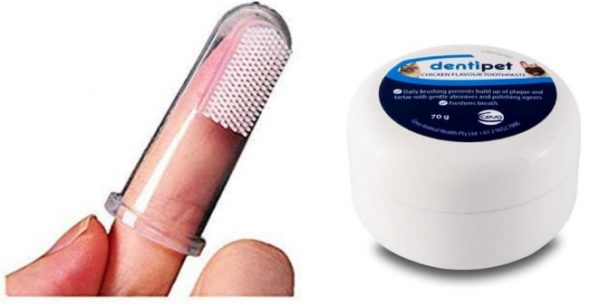How to Use a Finger Tooth Brush
Brushing your dog’s teeth is an important part of overall care. Like humans they can build up tartar and plaque leading to smelly breath and potential loss of teeth.
We’ve broken it down into easy steps and included videos to help guide you. Whilst it is preferable to start when your pup is young, there is no time like the present! Some dogs will be receptive to brushing, but if your dog is reluctant or acting aggressive, proceed cautiously.
It’s important to use positive reinforcement and a calm soothing voice. Keep the training to a few minutes at a time and try to train daily. If your dog continues to resist or to become agitated, give them a break and try again later or another day. Patience is important and it may take a few sessions to get them used to the process.
1. Prepare
 Start by getting everything ready. Purchase a finger brush and dog toothpaste. Do NOT use human toothpaste as it contains fluoride and xylitol which can be toxic to dogs. Dog toothpaste is available in many different flavors to help make brushing easier and more pleasant. Choose a time to begin training when the dog is calm and relaxed usually after exercising or playing also use their favourite treats as reward!
Start by getting everything ready. Purchase a finger brush and dog toothpaste. Do NOT use human toothpaste as it contains fluoride and xylitol which can be toxic to dogs. Dog toothpaste is available in many different flavors to help make brushing easier and more pleasant. Choose a time to begin training when the dog is calm and relaxed usually after exercising or playing also use their favourite treats as reward!
2. Touching the muzzle
This step can usually take a week or so to get correct so don’t be disheartened if they show resistance initially. Use lots of praise and rewards. Slowly and gradually get them used to having their muzzle touched. Don’t use unnecessary force.
3. Lifting the lips
Once they’ve gotten used to you touching their muzzle slowly begin to lift their lips to reveal their teeth. Remember to continue using praise and rewards.
4. Touching the Teeth
When they are allowing you to lift their lips with minimal resistance you can begin to gently touch their teeth individually. The canines are usually the easiest to start with as they are the most visible and accessible. Reward, Praise, Reward! If they are resisting give them a break or try starting back at step 2 – touching the muzzle.
5. Show the toothbrush then touch.
Next, show the toothbrush to your dog and let them inspect the brush. You can then continue with touching individual teeth with the tooth brush on. If they allow you to, continue to brush a few teeth. Then, slowly brush back and forth. This process is important to get them used to the feeling of the brush on their teeth and gums.
6. Add the toothpaste
Let the dog lick some toothpaste off the brush. Praise the dog for this behaviour. This will help the dog become accustomed to the taste. Slowly start brushing the teeth similar to Step 5 and gradually increase the number of teeth you brush each time until they’re comfortable having all of them brushed.
7. Routine
The more frequently you brush their teeth the easier it will become overtime. Brushing daily is ideal however if you are unable to, aim for as often as possible. If you notice any loose teeth, bleeding or foul smell stop brushing and give us a call. We’d be happy to book you in for a FREE dental check. Also, you can find out more about dental disease and treatment by checking out Dr Robbie’s blog – Dirty Teeth and Bad Breath.